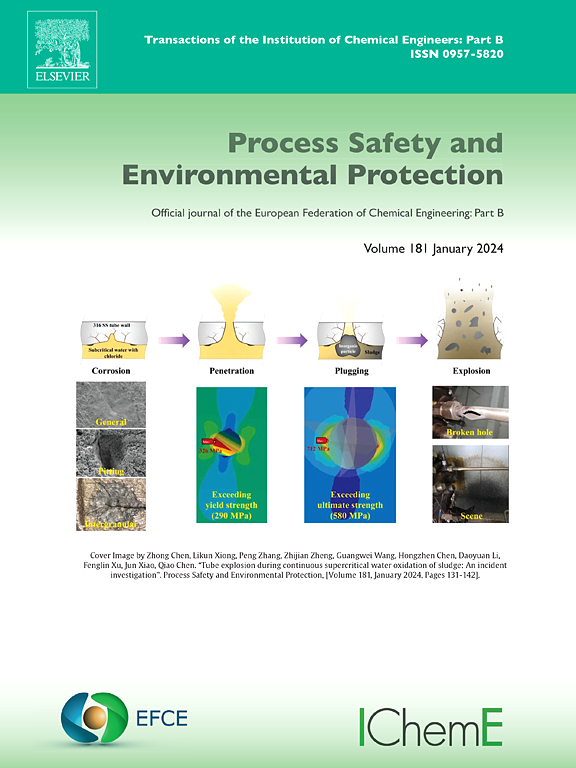Effective production of branched-chain biodiesel by the hydrolysis-esterification of castor oil using porous carbon-based solid acid
IF 7.8
2区 环境科学与生态学
Q1 ENGINEERING, CHEMICAL
引用次数: 0
Abstract
Using Chinese fir sawdust as a carbon source, a porous carbon-based solid acid was successfully developed and utilized for the hydrolysis-esterification of castor oil to produce branched-chain biodiesel. A series of characterizations proved that the CPS-400–2 possessed a large specific surface area (1129.86 m2/g), high total acid density (5.03 mmol/g) and abundant -SO3H density (1.68 mmol/g). The hydrolysis yield of castor oil reached 85.5 % under the conditions of hydrolysis temperature 160 °C, hydrolysis time 3 h, water/oil mass ratio 2:1, and catalyst dosage 6 wt%. Subsequent esterification of the resulting ricinoleic acid with isopropanol (molar ratio 18:1) at 160 °C for 2.5 h with catalyst dosage 5 wt% achieved 95.1 % esterification ratio. Combined with density functional theory calculations, a potential reaction pathway for the esterification of ricinoleic acid with isopropanol was proposed. And, the environmental assessment revealed that the hydrolysis-esterification process to produce the branched-chain biodiesel was an environmentally friendly technology. Finally, according to the LCC cost analysis results, using CPS-400–2 as the catalyst to product the biodiesel had relatively low cost.
利用多孔碳基固体酸水解-酯化蓖麻油有效生产支链生物柴油
以杉木木屑为碳源,成功开发了多孔碳基固体酸,并将其用于蓖麻油水解酯化制备支链生物柴油。一系列表征表明,CPS-400-2具有较大的比表面积(1129.86 m2/g)、较高的总酸密度(5.03 mmol/g)和丰富的-SO3H密度(1.68 mmol/g)。在水解温度160℃、水解时间3 h、水油质量比2:1、催化剂用量6 wt%的条件下,蓖麻油的水解率可达85.5 %。随后得到的蓖麻油酸与异丙醇(摩尔比18:1)在160℃下反应2.5 h,催化剂用量为5 wt%,酯化率为95.1% %。结合密度泛函理论计算,提出了蓖麻油酸与异丙醇酯化的潜在反应途径。环境评价结果表明,采用水解-酯化工艺制备支链生物柴油是一种环境友好型工艺。最后,根据LCC成本分析结果,使用CPS-400-2作为催化剂生产生物柴油的成本相对较低。
本文章由计算机程序翻译,如有差异,请以英文原文为准。
求助全文
约1分钟内获得全文
求助全文
来源期刊

Process Safety and Environmental Protection
环境科学-工程:化工
CiteScore
11.40
自引率
15.40%
发文量
929
审稿时长
8.0 months
期刊介绍:
The Process Safety and Environmental Protection (PSEP) journal is a leading international publication that focuses on the publication of high-quality, original research papers in the field of engineering, specifically those related to the safety of industrial processes and environmental protection. The journal encourages submissions that present new developments in safety and environmental aspects, particularly those that show how research findings can be applied in process engineering design and practice.
PSEP is particularly interested in research that brings fresh perspectives to established engineering principles, identifies unsolved problems, or suggests directions for future research. The journal also values contributions that push the boundaries of traditional engineering and welcomes multidisciplinary papers.
PSEP's articles are abstracted and indexed by a range of databases and services, which helps to ensure that the journal's research is accessible and recognized in the academic and professional communities. These databases include ANTE, Chemical Abstracts, Chemical Hazards in Industry, Current Contents, Elsevier Engineering Information database, Pascal Francis, Web of Science, Scopus, Engineering Information Database EnCompass LIT (Elsevier), and INSPEC. This wide coverage facilitates the dissemination of the journal's content to a global audience interested in process safety and environmental engineering.
 求助内容:
求助内容: 应助结果提醒方式:
应助结果提醒方式:


